#yohatsu hairstyle
Note
hi! i’ve heard that in tokyo, the geisha district kagurazaka is open to taking foreigners (i believe). if that is true, how would that necessarily happen? and how would it work? like certain hair types. for example, lets use me! i am a african american person who is light skin with curly hair. how would they make my hair into the way maiko have theirs? use a wig? get a lace front? etc etc.
Hey!
I can't confirm that, only know that the Kagurazaka Geisha Union is open for new Geisha/Hangyoku recruits.
You asked about the hair: The wigs ("Katsura") worn by Hangyoku or Geisha look like this (example of one specific hairstyle, but the structure is the same with all wigs): https://azuma-online.shop/?pid=178657614
Hangyoku's hair is usually not much longer than shoulder/scapula length, and for Geisha, even shorter works for Yohatsu, but a bob might be too short (Yohatsu uses hair padding, but as far as I know, no extensions - Azusa mentions here her hair is shorter than ever and she might have gone too far with cutting it).
All nine "foreign Geisha" I know of (starting from 2009) have/had straight hair. I'm not a hairdresser and don't have any experience with curly hair, but I don't see why Nihongami wouldn't work if you don't have straight hair, as long as it's long enough.
Let me link you some examples, so you can see for yourself how Nihongami works, and if it would be possible for you:
1. Some modern Nihongami with simple tools and no extensions on a wig head: https://www.youtube.com/watch?v=sNOH4wmVz1o
2. Tsubushi shimada on an actual person with extensions and hair padding, I think this is pretty close to the way Maiko/Hangyoku get their hair done: https://www.youtube.com/watch?v=QpBIX4YQBTo
3. Wareshinobu and Ofuku Kyo Maiko style: https://www.youtube.com/watch?v=PVoZSOS-wrQ
Hope this helps!
18 notes
·
View notes
Note
Hi, in early 20th century photos geisha, when not in their full regalia, are often depicted with a very fluffy hairdo. From what I can understand, the name of the hairstyle is sokuhatsu. When did geisha stop styling their hair like that and switched to modern (and far less voluminous) yohatsu? Was it done after World War II, simultaneously with the introduction of wigs, or has it been a more gradual thing? Thanks
It was a more gradual thing as sokuhatsu started to fall out of style by the 1930s (its peak popularity was in the 1900s through to the 1920s), and by the 1940s it had all but disappeared ^^
11 notes
·
View notes
Text
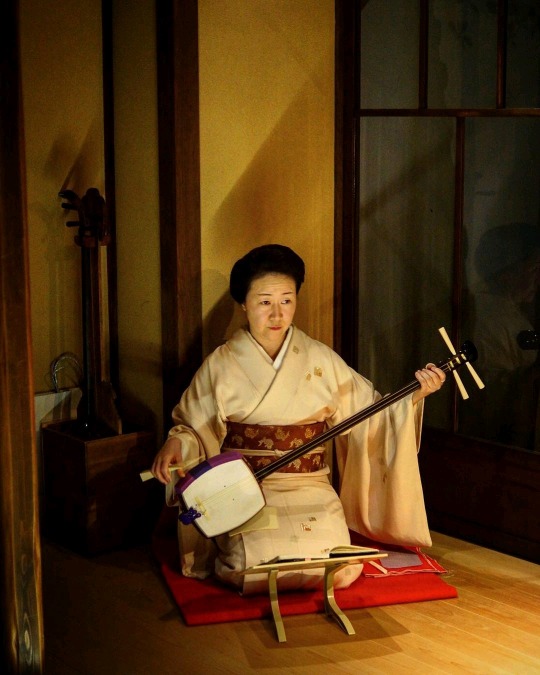
February 2019: Jikata Geiko Ichisumi (Ichi Okiya) of Kamishichiken playing the shamisen and singing at an ozashiki at the Umeno Ochaya.
Ichisumi debuted in September of 2016 directly as a Jikata Geiko, when she was already in her fourties. Her Misedashi was so low-key that, for about a month, I didn’t even know that she was around!
Except for Gion Kobu, all kagai of Kyoto allow women too old to become Maiko to debut directly as tachikata Geiko (dancers); however, the age limit for that is around 30 years old. Jikata Geiko can debut at all ages, there are several more recent example of jikata debuting well into their sixties.
That is not to say that women debuting as Jikata Geiko are simply too old to become tachikata; almost all of them are already proficient in music before entering training and see being a Jikata Geiko as their ideal profession.
Source: Kyoto Insider on Instagram
#ichisumi#ichi okiya#kamishichiken#houmongi kimono#houmongi#kimono#kosode#obi#obiage#obijime#shamisen#yoohatsu hairstyle#yoohatsu#yohatsu hairstyle#yohatsu#hairstyle#hair#nihongami#geisha#geiko#geigi#jikata geiko#jikata#maiko#karyukai#japan#japanese
80 notes
·
View notes
Photo

Today in Kamishichiken: maiko Katsuna’s erikae! Katsuna has chosen to become a jikata (musician) geiko, so instead of wearing katsura, oshiroi and hikizuri, she wears yohatsu (Western hairstyle) and a tomesode kimono (source). Congratulations Katsuna!
67 notes
·
View notes
Text
The look of... VIII: Shimizu 清水

Historical context
The first official date in the history of Shimizu Geigi is 1872, when "Machi Geisha" (まち芸者), who were distinct from "Kaku Geisha" (廓芸者), appeared. A Kenban (registry office) was established in 1877. At that time, Machi Geisha and Kaku Geisha combined were around twenty people. Only ten years later, in 1887, their number had increased to 100. The number of Geigi continued to grow.
In 1938, the number of Geigi was around 260, and they were highly regarded nationwide for their skills in art and behaviour. In 1951, a "Shimizu Geigi school" (清水芸妓学校) was opened, around 150 Geigi attending the event.

In the 1970's, Japan's period of economic growth started tapering off, interest in traditional arts dwindeled, which resulted in less work opportunities for Geigi and the number of Ryotei decreasing. In response to this, local business leaders and Shimizu Geigi started an organisation to help fostering new Geigi (Seibikai 清美会).
By 1985, their number had decreased to thirteen and the Kenban closed. In 1991, local businessmen and Geigi formed a different company (Seibi Co. 清美(株)), which worked as employer for Geigi. Due to a bad economic environment, Shimizu Odori (清水をどり) was last held in 1998, Seibi Co. was dissolved in 2004, and Haru no mai (春の舞) was discontinued in 2009. As a result of this, some of Seibi's employees became independent Geigi.
Allegedly, the number of Geigi hit rock bottom in 2011 with only two remaining. However, in 2012, around eleven Geigi worked in Shimizu. Since then, the city had a steady stream of Geigi coming and going again. At the end of this year, 2023, there are ten Geigi working in the city.
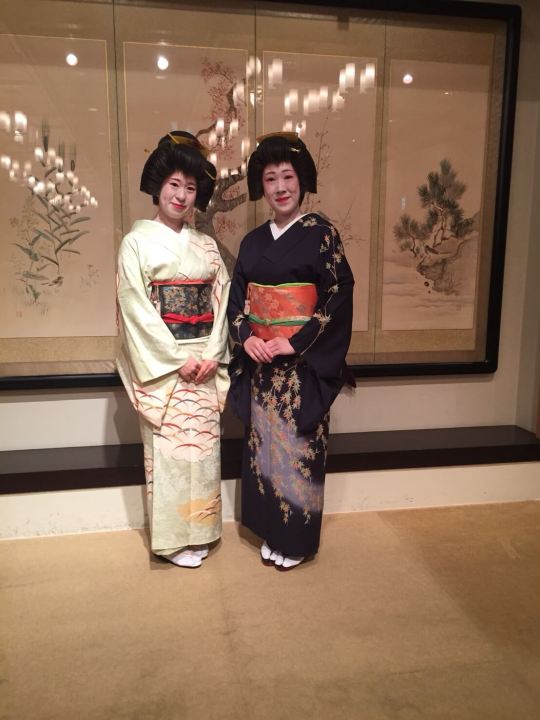
The look of Shimizu Geiko
Local Term: Geigi 芸妓
※ Hairstyle: Taka shimada, Tsubushi shimada
※ Kanzashi: Kushi, Maezashi, bekko kogai, ear of rice in the new year period
※ Kimono: Homongi, Kuromontsuki Hikizuri
※ Haneri: white
※ Obi: Taiko musubi
※ Obiage: green, pink, white, red
※ Obijime: flat, 1 knot
※ Footwear: Zori

Casual look
※ Hairstyle: Yohatsu
※ Kanzashi: none
※ Kimono: Homongi, rarely Komon
※ Haneri: white
※ Obi: Taiko musubi
※ Obiage: white, pink
※ Footwear: Zori

The look of Shimizu Maiko
Local term: Shinjin Geigi 新人芸妓
※ Hairstyle: Momoware Katsura, sometimes real hair styled (shin nihongami)
※ Kanzashi: seasonal and non-seasonal Hanakanzashi, Katsuyama, maezashi, Shidare in all age groups
※ Kimono: Furisode with shoulder tucks or no tucks at all
※ Eri: white with white embroidery, plain white, white with multicolour embroidery, other colours possible especially during summer months
※ Obi: Koken musubi
※ Obiage: flat, mostly red/silver, red/white shibori, other colours also possible (green/beige/light blue)
※ Obijime: flat or round with 1-4 knots. No obidome
※ Footwear: Zôri


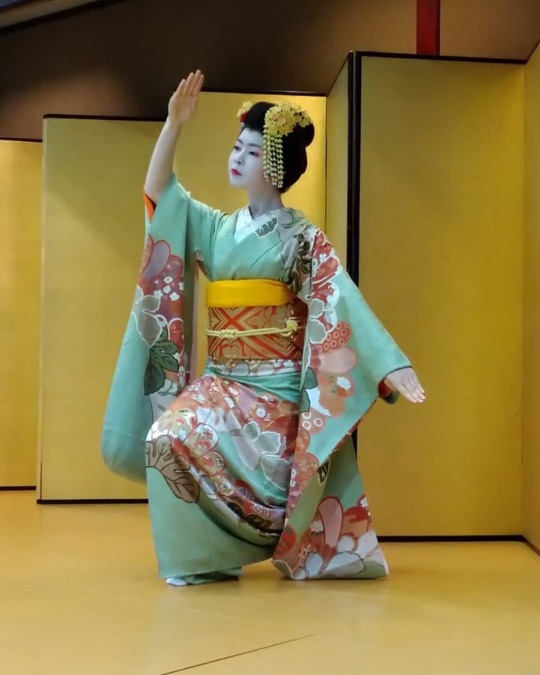

Notes
Shimizu was merged with Shizuoka in 2003. Shimizu Geigi and other traditional arts performers are backed by 静岡伝統芸能振興 Shizuoka dentô geinô Shinkô-kai/Shizuoka traditional performing arts promotion association, which is the successor to Seibikai. You might notice I didn't start this post with a historical b/w photo. There are some old photos on the Shizuoka Dentogeino homepage, but they are the size of a postal stamp. And that's it. I feel let down. No chance to explore the historical style of Shimizu.
Anyways. "The look of Shimizu/Shizuoka" was requested by @geimaiko. The layout of this post is based on geimaiko's own. Also... geimaiko originally started these series. If you liked this post, you should go and thank her, because without her, there would be no "the look of..." ;)
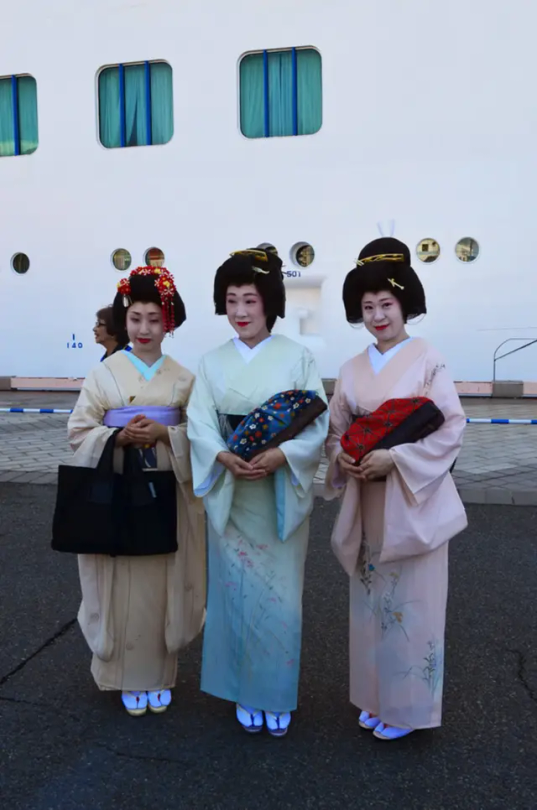

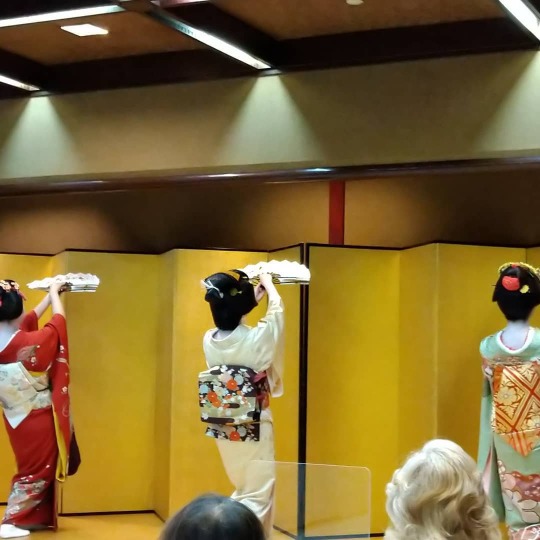
Sources
https://www.shizuoka-dentogeino.jp/geigi/shizuoka_history/, https://www.shizuoka-dentogeino.jp/geigi/shimizu_history/, http://www.shimizu-port.jp/geigi.html, https://www.nikkei.com/article/DGXNZO41971500Z20C12A5L61000/ (headline and preview only), https://www.youtube.com/@shizuokadentogeino/videos
Pictures: Komachi May 17, Makoto May 17, Komachi+Makoto Oct 17 (sources nowhere to be found), Sakurako+Fukutaro Apr 22, Kikuno+Umeka Nov 14, Iroha Jun 20, Iroha Oct 20, Fukutaro Oct 20, Ichiryo+Komachi+Makoto ~2016, Komachi+Sakurako Apr 18, Fukutaro+Sakurako Oct 18, Iroha+Fukutaro+Sakurako Oct 20
#mg#geisha#geiko#maiko#hangyoku#geigi#shizuoka#kimono#komachi#makoto#sakurako#fukutaro#kikuno#umeka#iroha
48 notes
·
View notes
Text
The look of... VII: Mukojima
Welcome to the 18th installment of this series (my 7th). This time, we’re having a look at the Geigi that work in one of Tokyo's Hanamachi: Mukojima (向島).
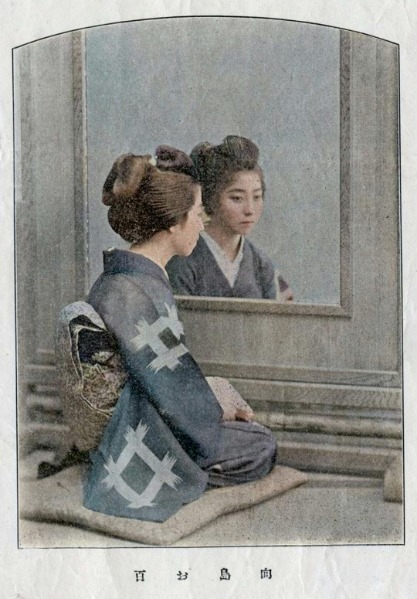
Historical context
Geisha started to live in Mukojima in the early Meiji period (1868-1912) [1]. From the Edo to Meiji period, Mukojima was a recreational area for the common people, and was frequented by Yanagibashi and Yoshiwara Geisha with their customers. [3] The earliest record of a Mukojima Geisha (known to me) is Omomo お百, who was featured in "Contemporary Beauties", 1897 [2]. In 1906, 30 Geisha lived in the area. By 1928, their number had increased to 239. In 1940, several Kenban united, further increasing the number of Mukojima Geisha to 1300. Like in all Hanamachi around Japan, the number declined steadily after the second world war. In 1951, their number was 600, in 1993 240 [7], in 1996 170, in 2007 120 [3], in 2020 around 90 [4]. This makes Mukojima approximately as populated as Gion Kobu and Tokyo's largest Hanamachi.
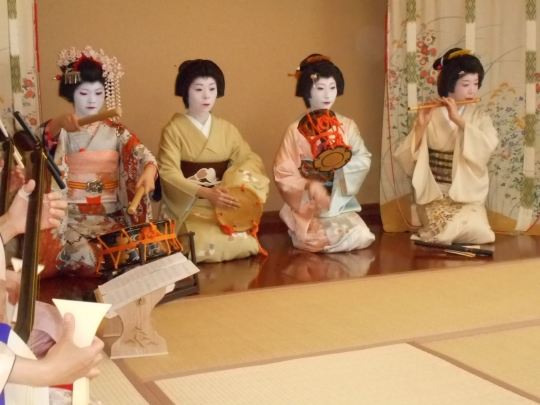
The look of Mukojima Geiko. Local Term: Geisha 芸者
※ Hairstyle: Geisha shimada, Tsubushi shimada
※ Kanzashi: Kushi, Maezashi, Hirauchi or Tama in the back, rice husk in the new year period
※ Makeup: Oshiroi
※ Kimono: everyday Kimono: Homongi. Kuromontsuki Hikizuri mostly in the new year period or for Erikae, rarely non-black Hikizuri.
※ Haneri: white
※ Obi: Taiko musubi, Yanagi musubi with Hikizuri
※ Obijime: mostly light-coloured. No obijime with yanagi musubi
※ Obiage: mostly red, pink, or white. Seldomly turquoise, white/green, white with red shibori (red/red-white shibori with Kuromontsuki)
※ Footwear: mostly Zori, also Geta



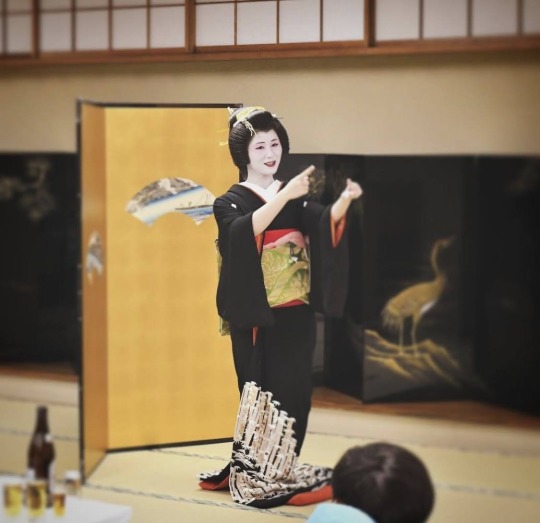
Casual/Jikata look
※ Hairstyle: Yohatsu
※ Kanzashi: none
※ Makeup: western makeup
※ Kimono: Homongi, Kurotomesode
※ Eri: white
※ Obi: Taiko musubi
※ Obijime: mostly light-coloured. In rare cases with pocchiri
※ Obiage: white with red shibori, pink, white, pink/turquoise
※ Footwear: Zori
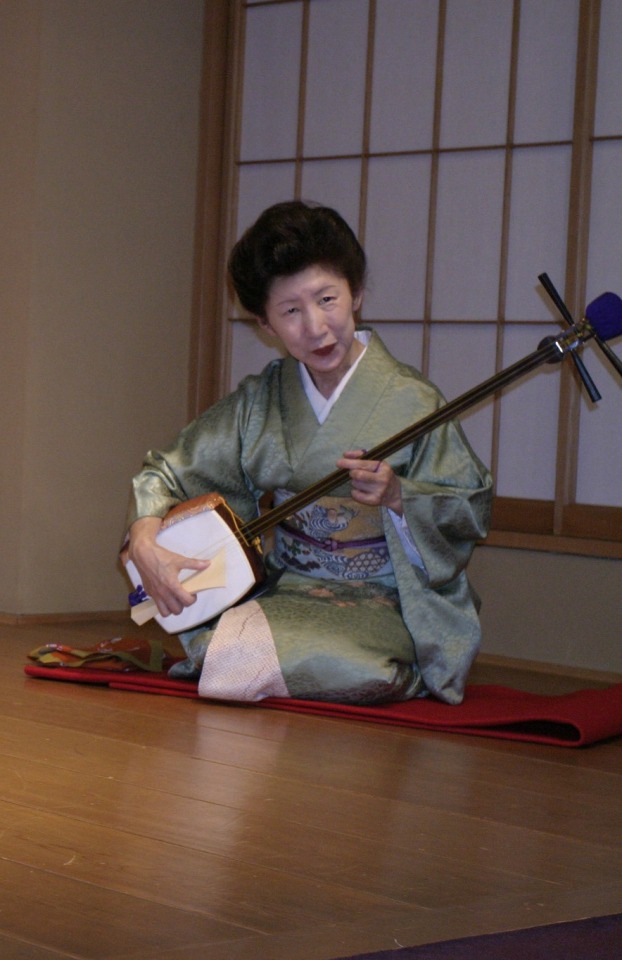
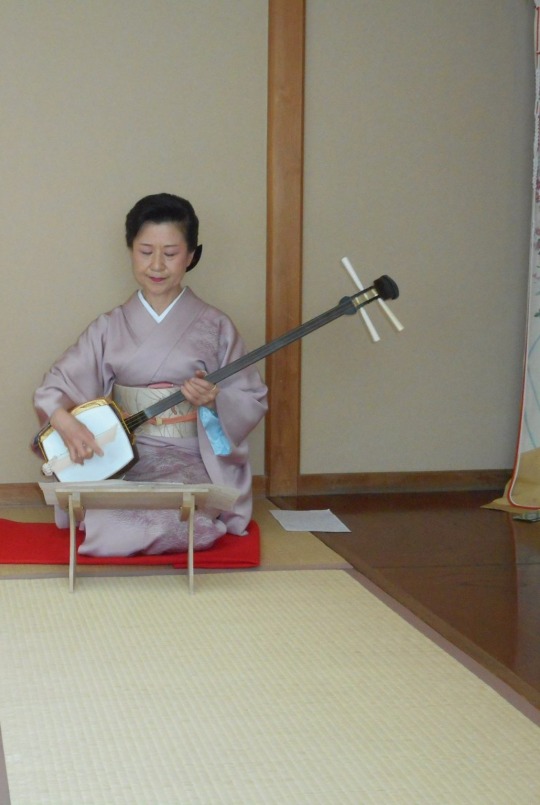
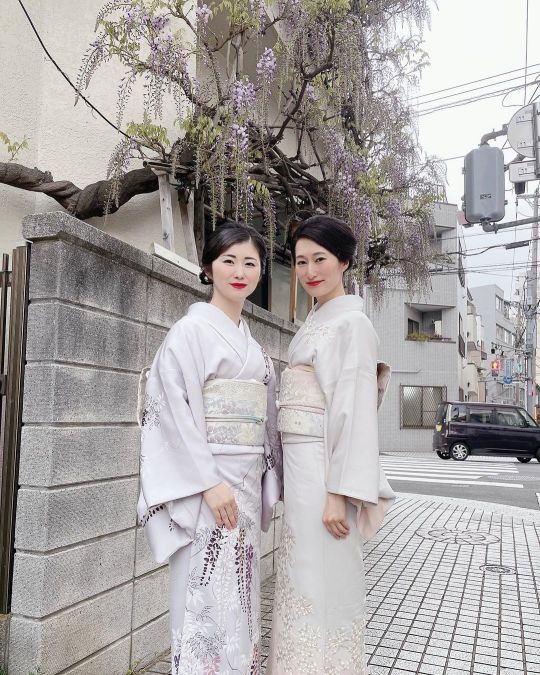
The look of Mukojima Maiko. Local term: Hangyoku 半玉
※ Hairstyle: Momoware (own hair or wig), Yuiwata for senior Hangyoku (only wig). Shibori, Kanoko and Chinkoro are mostly red, but can also be pink during summer.
※ Kanzashi: seasonal flower kanzashi (1-2 Daikan, Katsuyama, 1-2 Bira-Ôgi, Shidare popular for all ages), Maezashi (optional), Hirauchi. Minimal flower kanzashi with Yuiwata.
※ Makeup: Oshiroi, both lips painted from the start
※ Kimono: Furisode with or without tucks (all variations possible)
※ Eri: mostly white or red/white. But also pink/red, red/purple/green on white base, pink, green, black/pink/white, etc., etc.
※ Obi: kôken musubi
※ Obijime: light-coloured. sometimes with pocchiri
※ Obiage: most common colour variations are red/silver, or red/white shibori. But there are many other combinations.
※ Footwear: mostly Okobo (with red or pink straps), Zori
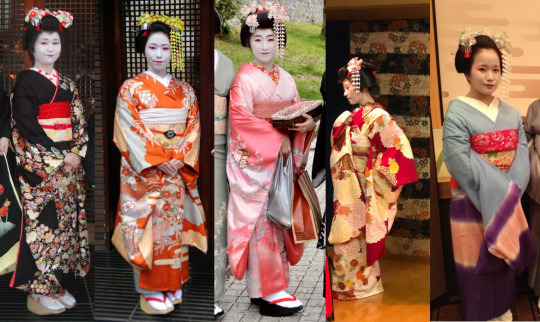
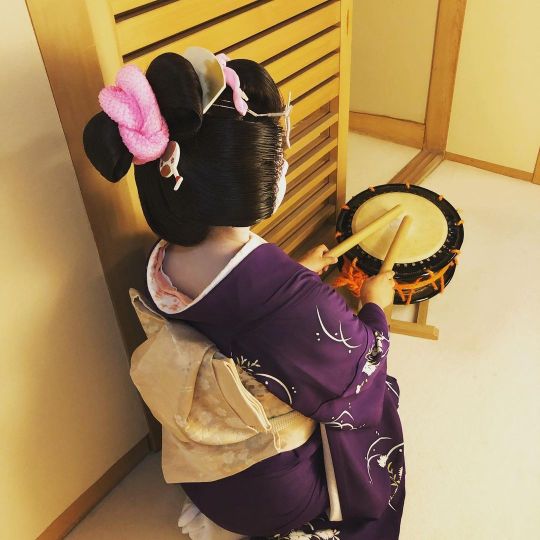
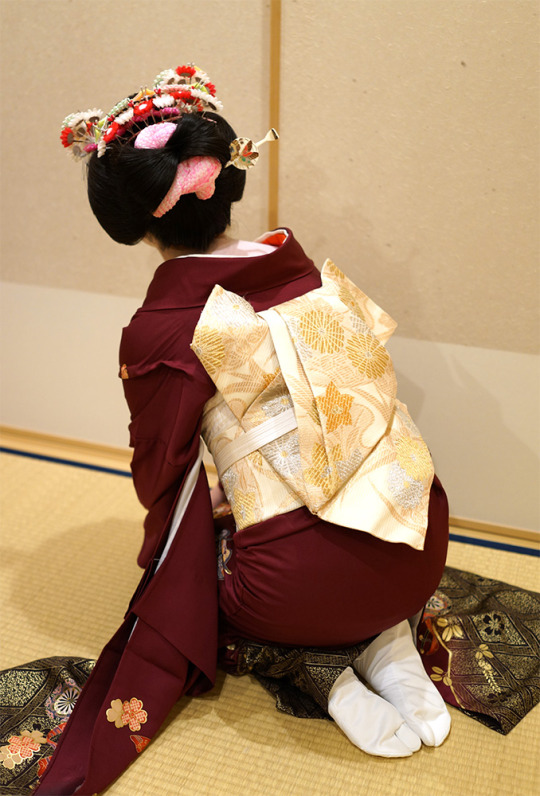


Dances [6]
Some dances that are local speciality of Mukojima:
※ Asazuma bune かさずまぶね
※ Fuji musume 藤娘
※ Fukagawa Kuzushi 深川くずし
※ Gorô ごろう
※ Mukojima ondo 向島音頭
※ O-Sumio お角力
※ Otemoyan おてもやん
※ Sôran bushi ソーラン節
※ Yosakuraya 夜桜や
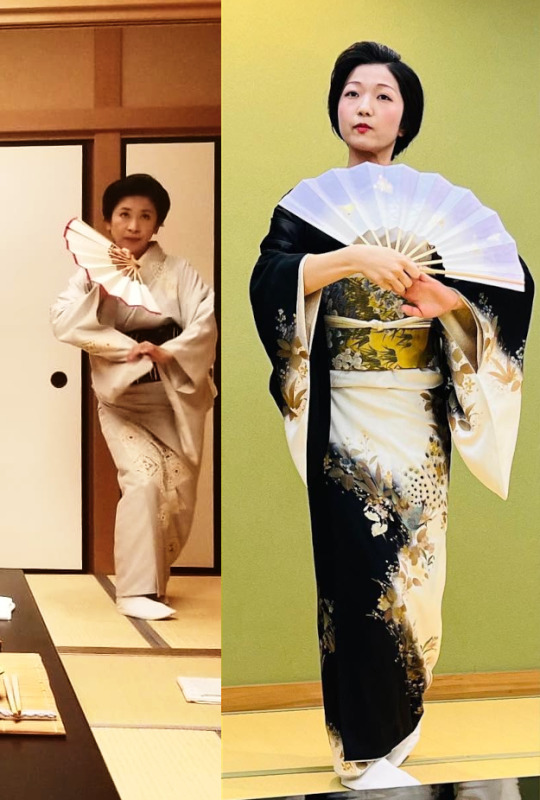
Others that you can also see in Ozashiki outside of Mukojima:
※ Ayame Yukata 菖蒲浴衣
※ Echigo Jishi 越後獅子
※ Hanami Odori 花見踊り
※ Hatsuharu 初春
※ Ina bushi 伊那節
※ Kiyari Kuzushi 木遣りくずし
※ Sawagi さわぎ
※ Setsuhonkaina せつほんかいな
※ Shichi fukujin 七福神
※ Takeda bushi 武田節
※ Tatsumi no hidarizuma 辰巳の左褄
※ Tsurukame 鶴亀
※ Yakkosan 奴さん
※ Yoshiwara Suzume 吉原すずめ

Notes
Mukojima allows part-time workers, calling them Kamome かもめ [5]. Most of them are students or work in a different job already. Their task is mainly assisting Geisha/Hangyoku in the Ozashiki. Kamome can become Hangyoku or Geisha if they wish to work full-time. Mukojima dancers also play instruments at ozashiki: Hangyoku frequently play shime-daiko, Tachikata more often play ko-tsutsumi, sometimes fue. Shamisen seems so be reserved for Jikata.
Usually, Ryotei and Okiya are separate businesses in Tokyo. In Mukojima, however, several Ryotei also function as Okiya [3], similar to how in Kyoto, several Ochaya also have an attached Okiya.

Sources - Text
[1] Foreign Press Center Japan, Mukojima Press Tour April 2006 https://fpcj.jp/en/assistance-en/tours_notice-en/p=6744/
[2] https://www.flickr.com/photos/blue_ruin_1/28442353867/
[3] numbers 1906-1951, 1996-2007: Sumi Asahara "Tokyo Rokkagai", 2007
[4] not an exact number (account required) https://www.tapatalk.com/groups/tsurukomaiko/hanamachi-population-reference-wip-t2000.html
[5] Kamome http://sengoku-japan.com/
[6] dances compiled at Tsurukomaiko, it's by no means a complete list (account required) https://www.tapatalk.com/groups/tsurukomaiko/list-of-dances-in-all-hanamachi-t1988.html
[7] 1993: Tsuiseki (追跡): The World of the Geisha, ca. 1993 https://www.youtube.com/watch?v=bkhRWNDwTyM
Sources - Pictures
Omomo ※ Kingyo Ozashiki ※ Momoka ※ Komachi ※ Yuki+Otokichi ※ Chikage ※ Senyume ※ Hiroya ※ Chikage+Natsuki ※ Tamaki ※ Shingetsu ※ Natsuki (twitter) ※ Soraka (insta) ※ Tomoka ※ Kingyo (fb) ※ Teruka 2x ※ Kanzashi ※ Kintaro (insta) ※ Ayame ※ Kingyo+Rin Ozashiki (fb) ※ Sakura matsuri 2023
I tried to trace back all pictures. If you find the missing links, let me know.
"The look of" other Hanamachi:
Yamagata, Tokyo Yoshicho, Niigata, Atami, Gifu, Tokyo Kagurazaka, Arima Onsen, Tokyo Asakua, Nagoya, Tokyo Shinbashi, Anjo
I Osaka Kitashinchi, II Tokyo Akasaka, III Osaka Nanchi, Fukuoka, V Yuzawa, VI Morioka
More Mukojima content: https://maigeiko.tumblr.com/tagged/mukojima
Layout: @geimaiko, thanks as always! ♥
70 notes
·
View notes
Text
Kamisuwa Onsen, collected random infos
Back in March, a reader of this blog asked for a blog entry in the vein of previous "the look of..." features, but for Kamisuwa Onsen 上諏訪温泉.
Sadly, there isn't much visual material available and the basic look of the 3 or less remaining Geisha boils down to: Yohatsu, Homongi, light-coloured Obiage, Otaiko Musubi, or the formal look: Tsubushi Shimada, Kurotomesode, red Obiage, Otaiko Musubi. So here, I present some collected random infos you might find interesting.

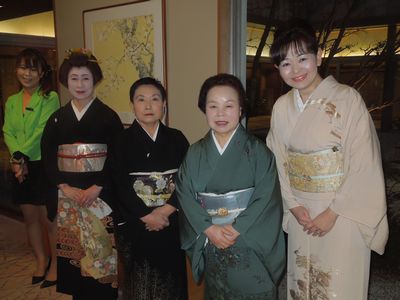
Kamisuwa Geisha, Setsubun 2014
Dances
Kappore かっぽれ
Takeda bushi 武田節
Kiso bushi 木曽節
Kohan bushi 湖畔節
Ina bushi 伊奈節
Shôchikubai 松竹梅 (performed in the new year season)
Tsurukame 鶴亀 (performed at wedding receptions and birthdays)
O-Suwa Takashi お諏訪節
Sukêto bushi スケート節 (Ice skating on lake Suwa)
Kirigamine kouta 霧ヶ峰小唄 (ice skating)
Onhashira kouta 御柱小唄
Suwa ondo 諏訪音頭 (about the beauty of Suwa throughout the seasons)
Okaya kouta 岡谷小唄 (about the Okaya silk industry)
Numbers
1930's ("early Showa period"): 200 Geisha in Kamisuwa
1958: 80
1960's: 300
2006: 3
History
The first Hanamachi on lake Suwa developed in Nawatemachi 縄手町/畷町 in 1903 (renamed to Otemachi 大手町 in 1909). In the following years, a few Ryotei were established. In 1920, the area of Otemachi 1 and 2 chôme was designated as area for Geisha, so Okiya and Ryotei of the neighbouring Izumichô area 和泉町 were moved there. In the early Showa period (1920's/30's), Okiya that were formerly located in Hamamachi also moved to Otemachi.
Kamisuwa had two kenban: Ote kenban 大手見番 and Koyanagi kenban 湖柳見番.
In Shimosuwa 下諏訪, it seems kenban had no specific names.
In Okaya 岡谷, there used to be another Koyanagi kenban 小柳見番 in the Honmachi area.
In Chino 茅野, there were Miyagawa kenban 宮川見番 (current Miyagawacho area), and Eimei kenban 永明見番 (current Nakacho area).
Before the around 1969/70, Geisha of these respective cities did not work in other cities. But with the decline of Geisha numbers, the Hanamachi in Okaya, Shimosuwa and Chino were no longer able to meet the demands of their customers, so it was allowed for Geisha from Kamisuwa to pad those numbers.

Chiyomaru 千代丸 in "Showa Meigiren", 1988
Daily life
Geisha usually practiced their respective arts (such as Narimono, Nagauta, Kouta, dance) until 15:00, afterwards they went to the beauty parlour to get their hair done, put on makeup and change into work clothes. Ozashiki usually lasted for two hours.
Style
In the year 1935, Geisha still wore their natural hair instead of wigs, and their hairstyle changed, depending on rank and age. Hangyoku wore Momoware 桃割れ and Oshidori おしどり. Geisha under 26 years wore Yuiwata 結い綿 or Taka shimada 高島田, no info on Geisha between 26 and 30, Geisha aged 31 and above wore Geiko yui 芸こ結い, tsubushi (shimada?) つぶし, icho gaeshi 銀杏���, and yokai maki 夜会まき.
Around 1955, most Geisha wore short hair or western updos on a daily base and used Nihongami wigs for work.
Becoming Geiko
Three mediators who acted as go-between of Okiya and families/volunteers worked in Kamisuwa. According to Manchiyo, who worked from 1930 to 44 in Otemachi, the daughters of poor farmers and travelling entertainers were sold to the Okiya for 15 yen. When the parents met with the Okiya, the length of the girl's service was decided.
After becoming employed by the Okiya, the girls were doing "odd jobs", while taking lessons in Hanayagi-ryu dance, Shamisen and other arts. It's like Shikomi in Kyoto, although no specific term is named.
When a Hangyoku was ready to become a Geisha, she had to prove her skills in dance or shamisen to a council of dance/shamisen teacher, Okiya owner, senior Geisha, head of the Geisha association and a member of the Kenban. The Okiya spent around 30 yen for an Erikae, while the Geisha had to take a loan of 150-200 yen. If her parents were to borrow money during her time before becoming independent, it was added to her loan. If parents continued to ask for money and the Geisha's debt became too large, they often became prostitutes in order to pay off their debts.
Around 2 years after becoming Geisha, they became "Goshugi tori" ご祝儀取り - they receive some of the money from the Gyokudai, but tips were entirely for them to keep. The next level was called "share" 分け, when 40% of all earnings were her own. When becoming independent from their Okiya, they paid fees for food and being registered at the place. Most Geisha also had a patron after becoming independent, which also lead to most of them retiring before the age of 30.
@gardengeisha yes, this is about Kamisuwa Onsen located in Suwa-gun in Nagano prefecture!
Sources:
https://www.saginoyu.com/blog/10090 (2014)
地方花柳界における〈芸〉と〈色〉諏訪湖沿岸 地域の事例 (2015)
花街文化伝える学校が開校/長野・上諏訪温泉 (2008)
はなあかり: 昭和名妓連 (1988)
40 notes
·
View notes
Text
The look of... VI: Morioka
Welcome to the 17th installment of this series (my 6th). This time, we’re having a look at the Geigi that work in Morioka.
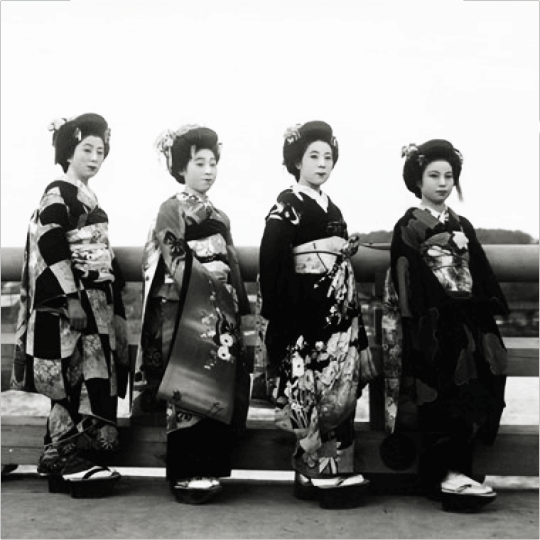
Historical context
It's not known when Geigi in Morioka started to exist, but they trained with Tokiwazu Rinchu 常磐津林中 who lived in Morioka from 1892-93. At this time, Morioka had two Hanamachi: Hatamachi 幡街 and Honmachi 本街. Hatamachi was frequented by customers of the merchant class, whereas Honmachi was the government office district, so the Ryotei there were mostly frequented by government workers and politicians.
From 1898 onwards, they were training dance with Wakayagi Rikiyo I 初代若柳力代, originally a Kabuki actor who turned to teaching in his later carreer.
In 1911, 54 Geigi worked in Hatamachi and 41 in Honmachi. 30 Ryotei operated in the entire city.
In 1913, the Morioka theatre was opened and the Joruri piece "Hanabutai chiyo kaomise" 花舞台千代顔見 was composed by Matsumoto Koshiro VII 七代目松本幸四郎, who invited the Morioka Geigi along him. The lyrics were passed down orally along with the choreography. This joruri piece is performed by the Geigi up to this day.
Coming to the present day, the segregation of "Hatamachi" and "Honmachi" no longer exists. They are all "Morioka Geigi", no matter where in the city they live. The Kenban no longer exists and there are no Okiya, all Geigi are independent. After a span of 19 years with no fresh blood, two young Geigi debuted in Morioka in 2012, followed by two Hyoko (Maiko) in 2016.

The look of Morioka Maiko
Local Term: Hyoko ひよ妓 - used to be called Hangyoku 半玉
※ Hairstyle: Momoware Katsura
※ Kanzashi: Manjugiku 萬寿菊 all year (2 sets: white/pink/green, white/red/green). Katsuyama and Daikan. First year with Shidare. Rice husk in the new year period. 1 Birabira, 1 Hirauchi, red Kanoko
※ Makeup: Oshiroi, both lips painted
※ Haneri: red with white embroidery, seldomly white
※ Kimono: Furisode without tucks
※ Obiage: flat, tied in the back. red/silver, red/white shibori, July-September: single colour pink and light yellow, white
※ Obi: Koken musubi
※ Obijime: round, flat, single knot
※ Footwear: Zori

The look of Morioka Geiko
Local Term: Geigi 芸妓
※ Hairstyle: Geiko shimada
※ Kanzashi: Kushi, Maezashi, rice husk in the new year period
※ Makeup: Oshiroi, both lips painted
※ Kimono: Homongi, Kurotomesode
※ Haneri: white
※ Obi: Taiko musubi
※ Obiage: red, pink, white with red Shibori (with Kurotomesode always white/red), white
※ Footwear: Zori


Casual look
Young and old Geigi alike often opt for a simpler look, both when dancing and when playing Shamisen…
※ Hairstyle: Yohatsu
※ Kanzashi: none
※ Makeup: no Oshiroi
※ Kimono: Homongi, Kurotomesode
※ Eri: white
※ Obi: Taiko musubi
※ Obiage: white
※ Footwear: Zori
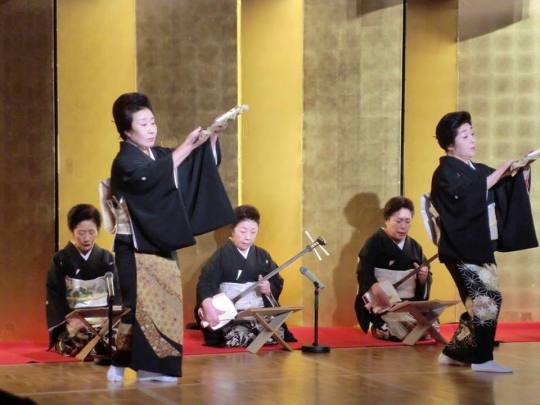

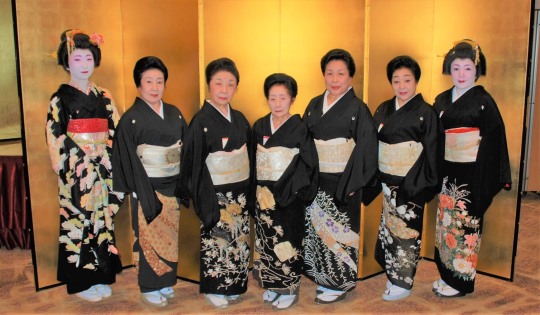
Dances
In comparison to other small Hanamachi, more than just two or three dances of their repertoire have been documented:
※ Aki no yo 秋の夜
※ Enkaina 縁かいな
※ Furyufunazoroi 風流船揃
※ Hanabutai Chiyo Kaomise 花舞台千代顔見
※ Haru kasumi 春霞
※ Harukoma 春駒
※ Kimigayo Shochikubai 君が代松竹梅
※ Kishi no Yanagi 岸の柳
※ Kanayama odori karame bushi 金山踊からめ節
※ Mori no nagame 杜の眺め
※ Nanbu ondo 南部音頭
※ Natsu to kabocha 茄子とかぼちゃ
※ Sekizoro せきぞろ
※ Yama wa iro nasu 山は色なす
※ Yûgure 夕暮れ
Check out the video linked below, the channel has more videos of this kind.

Notes
※ The joruri piece "Hanabutai Chiyo kaomise" received updated lyrics in 2013, reflecting the passage of 100 years after its creation. It's now called "Hanabutai Chiyo kaomise - Heisei version" 平成版 花舞台千代顔見.
※ The local term for the registry office was chosen to be "函番". Mostly pronounced Kenban like the Geigi registry offices all over Japan, but also "Kanban". The "函" character was also used for the Shamisen case - Geigi's Shamisen were stored in the Kenban and from there, brought to the Ryotei if needed.
※ Geigi Yôko よろ子 is Wakayagi Rikiyo IV.
※ Apprentice Geigi start dance training first, beginner dances being Kanayama Odori and Nanbu Ondo. Second the start training Shamisen and third Nagauta.
※ The b/w photo of the hangyoku is literally the only photo of Morioka Gei-/Maiko from before 2012 I was able to find. You can see the girls are wearing their own hair, Hikizuri and Darari Obi. The style has changed drastically!
※ This particular feature on Morioka was requested by @geimaiko. Thanks for the impulse!
※ If anyone reads this far... I’m happy to explore more Hanamachi. If you have a request, feel free to drop it in my inbox. An overview of what has received in-depth research before, you can find here.
Sources
※ text: past Hanamachi, 1911 numbers, beginner training, school of dance Wakayagi-ryu, kenban/okiya system defunct, 1993 debut (only mentioned, no picture of it, sadly!), everything else
※ dances: hanabutai, harukoma, nanbu+karame+haru kasumi (video), aki+natsu, kishi, yama+enkaina+sekirozo, furyu, mori+yugure, kimigayo (followers-only account)
※ pictures: collage 1: beige flower furisode, Kikumaru/Marika debut, dark blue furisode, collage 2: all from Kikumaru’s instagram, Tomochiyo/Tomiyu debut, Kikumaru erikae, jikata in sepia tones, new year’s photo (Facebook), veteran geigi dancing (Facebook), 3 geigi dancing. Hangyoku.
[Facebook has been restricting browsing for people who are not logged in recently, so I can’t look up the exact sources. Kikumaru’s instagram is private]
※ Original layout: @geimaiko ♥
72 notes
·
View notes
Text
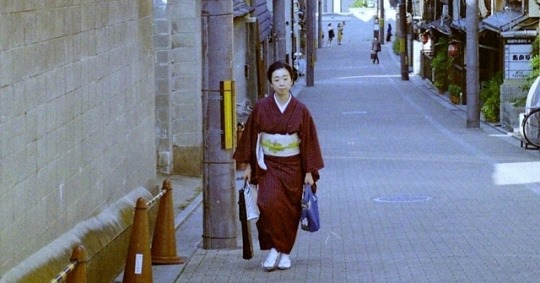
January 2019: Jikata Geiko Fukunami (Minoya Okiya) of Gion Kobu on her way to an engagement.
Other than most Jikata Geiko in Gion Kobu, Fukunami debuted as a Maiko in 1990 and switched to being a Jikata shortly after becoming a Geiko in 1995. She has been active for a total of 29 years, is around 44 years old right now and became a natori Geiko years ago.
Source: luciagq on Instagram
#fukunami#minoya okiya#gion kobu#kimono#houmongi kimono#houmongi#kosode#obi#obiage#obijime#yoohatsu hairstyle#yoohatsu#hairstyle#hair#yohatsu hairstyle#yohatsu#geisha#geiko#geigi#jikata geiko#maiko#nihongami#tomesode
58 notes
·
View notes
Text
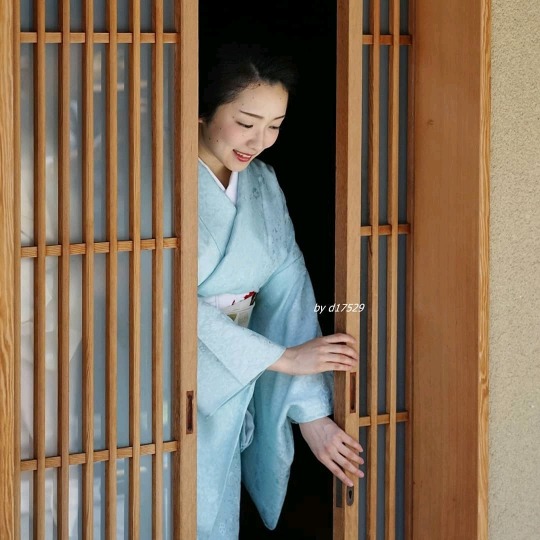
August 2018: Famous Geiko Toshimana (Komaya Okiya) of Miyagawacho opening the entrance door to an ochaya she just visited during Hassaku.
Toshimana had her Misedashi on the 26th of January in 2010, just 6 weeks after her best friend Geiko Toshikana, and had her Erikae on the 7th of March in 2013, so she was a Maiko for less than 3 years and 2 months, which is impressively short.
Toshimana had taken lessons in traditional dance for years before becoming a Maiko, and was so advanced and determined that her okaasan figured it would be unfair to hold her back behind her skill-level and she thus had her Erikae about 1 and a half year earlier than most Geiko do.
Toshimana quickly rose to fame during her Maiko days already, due to her beauty, artistic skills and calm and cheerful nature. She is currently the second most senior Geiko affiliated with Komaya and is just 23 or 24 years old.
Source: d17529 on Instagram
#toshimana#komaya okiya#miyagawacho#kimono#houmongi kimono#houmongi#kosode#obi#obiage#yoohatsu hairstyle#yoohatsu#hairstyle#hair#yohatsu hairstyle#yohatsu#nihongami#hassaku#geisha#geiko#geigi#maiko#karyukai#japan#japanese#kyoto
163 notes
·
View notes
Photo

April 2018: Natori Geiko Mameya (Ninben Okiya) of Gion Kobu performing at the famous Ichiriki-tei.
Mameya had her Misedashi in 1993 and her Erikae in 1998, so she has been active in Gion Kobu for 25 years and should be 40 or 41 years old right now.
She originally debuted from Shibata, but moved her affiliation to Ninben not too long ago.
Source: Lonny Chick on Instagram
#mameya#ninben okiya#gion kobu#kimono#houmongi kimono#houmongi#obi#obiage#obijime#kosode#yoohatsu hairstyle#yoohatsu#hairstyle#hair#yohatsu hairstyle#yohatsu#nihongami#geisha#geiko#geigi#natori#natori geiko#maiko#bnw#black and white#karyukai#japan#japanese#kyoto#photography
191 notes
·
View notes
Text

August 2018: Maiko Umechie (Umeno Okiya) of Kamishichiken performing at an banquet, while Jikata Geiko Katsuna (Daimonji Okiya) plays the shamisen and sings.
Sadly, Katsuna will retire at the end of this month, and Umechie will retire at the end of next month. They are two of the most famous Geimaiko of Kamishichiken.
Source: H. Ishibashi on Instagram
#katsuna#daimonji okiya#umechie#umeno okiya#kamishichiken#kimono#yukata#kosode#obi#obijime#yoohatsu hairstyle#yoohatsu#yohatsu hairstyle#yohatsu#ofuku hairstyle#ofuku#hairstyle#hair#hairpin#hair ornament#comb#kushi#nihongami#geisha#maiko#geigi#geiko#karyukai#japan#japanese
92 notes
·
View notes
Photo

July 2018: Geiko Mameroku (Arai Okiya) and Geiko Masaki (Minoyae Okiya) of Gion Kobu at the Yasaka Shrine during Miyabi-Kai.
Source: K.W.C. Photo - Blog
#mameroku#arai okiya#masaki#minoyae okiya#gion kobu#miyabi-kai#kimono#yukata#kosode#obi#ama coat#yoohatsu hairstyle#yoohatsu#hairstyle#hair#yohatsu hairstyle#yohatsu#nihongami#geisha#geiko#geigi#maiko#karyukai#japan#japanese#kyoto#yasaka shrine
202 notes
·
View notes
Text
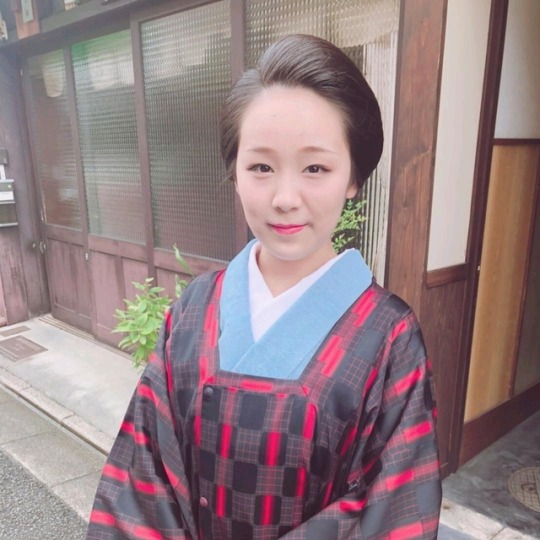
1st September 2018: Maiko Koyoshi (Shigemori Okiya) of Miyagawacho did her hiki iwai rounds today.
Hiki Iwai is the rite that Geiko perform at the end of their career. They give rice and pieces of paper containing their geimei (artist name) and real name on them to okiya, ochaya, sisters and customers who have supported her throughout her career to them thank them.
Only in Miyagawacho, Maiko who have completed their apprenticeship are also allowed to perform Hiki Iwai; in all four other kagai of Kyoto, only Geiko are allowed to do so.
Koyoshi had her Misedashi on the 19th of December in 2012, so she was a Maiko for over 5 years and 8 months, which is a very long Maiko period. Her definite reason for retirement is unknown, but since she purposefully stayed a Maiko for as long as possible because she enjoyed it so much, it‘s very likely that she wants to try out other opportunities in life and feels now (she is 21) would be the right time to do it.
Koyoshi has a very successful career and many achievements to be proud of. I wish her all of the best for her new life!
Source: tomoko.kikuehotel on Instagram
#koyoshi#shigemori okiya#miyagawacho#hiki iwai#kimono#houmongi kimono#houmongi#kosode#ama coat#yoohatsu hairstyle#yoohatsu#hairstyle#hair#yohatsu hairstyle#yohatsu#nihongami#geisha#maiko#geigi#geiko#karyukai#japan#japanese#kyoto
74 notes
·
View notes
Photo
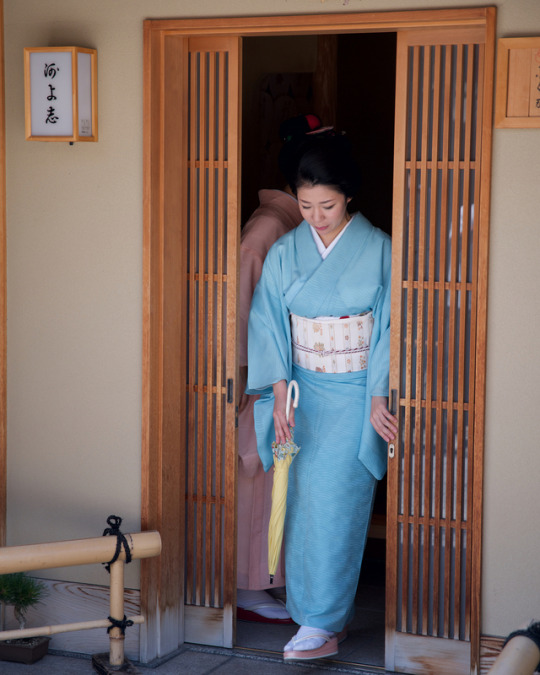
Agust 2018: Sisters Geiko Koume and Maiko Koaki (Kaden Okiya) of Miyagawacho leaving the Kawayoshi Okiya after visiting to pay their respects during Hassaku.
Only in Gion Kobu do the Maiko and Geiko wear full formal ensembles during Hassaku; in all other four kagai of Kyoto, they wear more casual kimono: houmongi for Geiko and komon for Maiko.
Source: tigertakashi on Instagram
#koume#koaki#kaden okiya#kawayoshi okiya#miyagawacho#hassaku#kimono#houmongi kimono#houmongi#kosode#obi#obiage#obijime#yoohatsu#yoohatsu hairstyle#hairstyle#hair#yohatsu hairstyle#yohatsu#geisha#maiko#geigi#geiko#wareshinobu hairstyle#wareshinobu#hairpin#hair ornament#comb#kushi
121 notes
·
View notes
Text
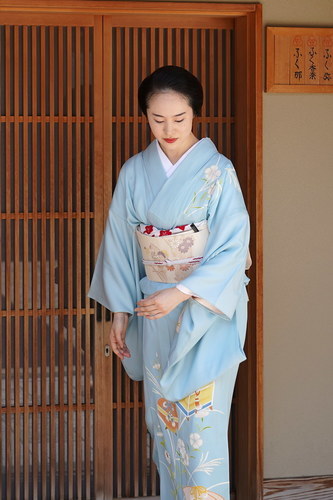

September 2018: This definitely confirms the rumors: Maiko Fumiyoshi (Yoshifumi Okiya) of Miyagawacho has retired after completing her apprenticeship as she was doing her hiki-iwai rounds today.
Fumiyoshi had her Misedashi on the 19th of January in 2015, so she was a Maiko for only 3 years and 8 months, which is below average, but since she was already promoted to a senior Maiko after being active for just 20 months due to her quick artistic progress her apprenticeship was probably considered complete.
It’s a real shame that she is retiring, she was one of my favourites and was Yoshifumi’s only Maiko and was a very promising candidate for a Geiko. Her retirement comes as a real surprise to me. Nonetheless, I of course wish her all of the best in her new life!
Source: ono-komati - Blog
#fumiyoshi#yoshifumi okiya#miyagawacho#hiki iwai#kimono#houmongi kimono#houmongi#kosode#obi#obiage#obijime#yoohatsu hairstyle#yoohatsu#hairstyle#hair#yohatsu hairstyle#yohatsu#nihongami#geisha#maiko#geigi#geiko#karyukai#japan#japanese#kyoto
50 notes
·
View notes